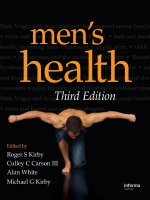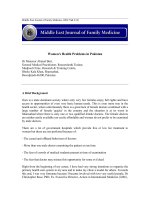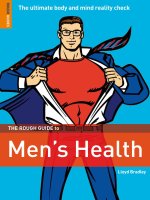Men''''s Health Huge in a Hurry: Get Bigger, Stronger, and Leaner in Record Time with the New Science of Strength Training_3 pot
Bạn đang xem bản rút gọn của tài liệu. Xem và tải ngay bản đầy đủ của tài liệu tại đây (34.09 MB, 98 trang )
LATISIIMUS DORSI
UPPER-BODY PULLS
The exercises in this chapter work the muscles that act on three major joints:
SHOULDERS
Your LATISSIMUS DORSI are the prime movers for your ball-and-socket shoulder joints when you
pull your upper arms down or in toward your body, aided by your REAR DELTOIDS. Classic
exercises for these muscles include lat pulldowns, pullups, and rows.
SHOULDER BLADES
The diamond-shaped TRAPEZIUS muscle starts at the base of your skull, spreads out to the back of
your shoulders, then runs down to the middle of your back. The upper part of the muscle pulls your
shoulder blades upward, as in shrugs and upright rows. The middle part brings them in toward
each other, an important part of rowing exercises. The lower part pulls your shoulder blades down
and toward each other, which happens when you do pullups and lat pulldowns. Beneath the traps
are your LEVATOR SCAPULAE and RHOMBOIDS, which assist in most of these actions.
ELBOWS
I don't need to remind anyone reading this book that your BICEPS flex your arms at the elbow joints.
You probably figured this out in kindergarten. Beneath the biceps is a thick, strong muscle called the
BRACHIALIS. It works
hardest when you pull with a grip that's neutral (your palms facing each
other) or overhand. Your biggest forearm muscle, the BRACHIORADIALlS, assists your brachialis.
1»
PULLUP AND CHINUP
PREP: You'll need a bar strong enough to hold your weight and high enough to allow a full range of
motion; the kind of bar that you twist into a door frame won't work unless you're really short or the
door is really tall. You'll start each repetition hanging from the bar with your arms fully extended
overhead. You can keep your legs straight, or bend your knees and cross your feet behind you.
If you need to use more weight for low-rep sets, use a ch in-dip belt (which looks like a regular
weight belt but has a chain in front to which you attach weight plates or a dumbbell), or hold a
dumbbell between your feet.
UP: Pull yourself up until your chin is over the bar.
DOWN: Lower yourself to the starting position .
VARIATIONS:
1» CHINUP
WHERE IT IS: Get Big, Phase 1; Get Even Bigger; Get Strong, Phase 1; Get Even Stronger, Phases J.
and 3; Get Lean, Phase 1
HOW TO DO IT: Use a shoulder-width, underhand grip.
208
WHAT IF I CAN'T DO ENOUGH
PULLUPS OR CHINUPS?
With the advent of Universal machines in the 1960s and '70s, the chinup became a forgotten
exercise. Even lifters who were strong enough for them opted for lat pUlldowns. And, of course,
many novice lifters aren't yet strong enough.
If you can 't do enough pullups or chinups with your body weight to complete the workouts as
written, you have two options: One is to use an assisted-chinup machine, a staple of newer gyms,
which allows you to replicate the body-weight exercise. If you have access to one and need to use
it, push yourself to reduce the amount of assistance you get from the machine, with the goal of
working with your own body weight as soon as possible.
Without access to that machine, you can use an advanced technique called rest-pause , which
I describe in Chapter 13. You 'll get on the bar and do two or three reps, drop off, catch your breath,
then jump back up and do the next. When you've done enough to complete a set (four to six, if the
workout calls for "heavy" weights), take the full rest period. After the first set, do as many as you
can per set-even if it's just one or two-and then take the designated rest period.
That's only practical if you can do a couple of reps at a time. If you can only do one at a time,
you could spend a half-hour trying to reach your target on a single exercise, which isn't a good way
to invest your time.
Try this instead : Set up a chair or bench beneath the bar. Grab the bar, and lift your feet off the
chair. From a dead hang, do as many reps as you can, even if it's just one. Then lower your feet to
the chair, and do the rest of the reps in that set, pushing off with your feet to assist your back and
arm muscles. The only way this works is if you use the push-off as little as possible-each rep
should feel difficult, as if you 're lifting almost all your body weight.
The last and worst option is to use lat pulldowns as substitutes for pullups and chinups, using
appropriate weights and grips that match the ones I prescribe. It's still a decent exercise, but not
nearly as beneficial to your entire body as the exercises you're replacing .
207
PULLUP AND CHINUP
[CONTINUED)
2»
SUPRAMAXIMAL
CHINUP
VVHEREITIS:GetEven
Stronger, Phase 1
HOVV TO DO IT: Use a
load that's
approximately 20
percent more than your
one-rep max. You can
3» FAST
PARTIAL CHINUP
VVHEREITIS: GetEven
Stronger, Phase 3
HOVV TO DO IT:
Starting with straight
arms, pull yourself
halfway up.
4» PULLUP
5»
VVHERE IT IS: Get Big,
SUPRAMAXIMAL
PULLUP
Phase 2; Get Even
Bigger, Total-Body
HFT; Get Even Stron-
VVHERE IT IS: Get Even
Stronger, Phase 3
ger, Phase 3
HOVVTO DO IT: Use a
HOVV TO DO IT: Use an
overhand grip that's
narrow-your hands
load that's
approximately 20
add weight with a chin-
should be slightly less
than shoulder-width
dip belt, or hold a
apart.
dumbbell with your feet.
Start from the hang
position, pull yourself up
2 inches, and hold.
208
percent more than
your one-rep max.
Start from the hang
position, pull yourself
up 2 inches, and hold.
6» WIDE-GRIP
PULLUP
7» NEUTRAL-GRIP
PULLUP
WHERE IT IS: Get
Strong , Phase 2;
WHERE IT IS: Get Big,
Get Even Stronger,
Phase 2
Bigger, HFT for Arms;
Get Strong , Phase 3;
HOW TO DO IT: Use an
Get Lean, Phases lA,
overhand grip that 's as
wide as comfortably
2A, and 3A
possible.
Phase 3; Get Even
comes closest to
left on one rep and to
shoulder width. If you
don't have access to
the right on the next.
fixed neutral-grip
resort to using a V bar. make
sure you keep one hand on it
at the end of your set. If you
Let go with both hands, it'LL
faLL off the chinup bar. with a
high likelihood of hitting you
on the head .
handles, borrow a V bar
from the lat-pulldown
station (it's shaped like
a triangle that's open
HOW TO DO IT: Most
on one side) . Rest the
hinge of the V bar
gyms will have a pullup
station with handles
that allow your palms
lengthwise on a regular
chinup bar, with the
gripping handles below
to face each other. If
Caution: If you have to
it on either side. Grab it
and alternate your reps
you have multiple
neutral-grip choices ,
select the one that
so that your head goes
above the bar to the
209
LAT PULLDOWN
WHERE IT IS: Get Big, Phase lA
PREP: Attach the long, straight bar to the high cable of the lat-pulldown station. Sit on the seat and
adjust the knee supports for comfort. (You can also lift the knee supports so they're above your
actual knee height, to avoid using them altogether. This adds some challenge to your core muscles.) Now stand, grab the bar overhand with a grip that's just less than shoulder width, and return
to the seat.
DOWN: Pull the bar down until it touches your chest. A good self-coaching cue is to imagine you're
pushing your chest out to meet the bar. You want to keep your torso vertical and your lower back in
its natural arch, but you also want your upper back-the thoracic spine-to arch as you contmct
your upper-back muscles.
UP: Return the bar to the starting position.
210
1
»
VARIATIONS:
1
»
UNDERHANDGRIPLAT
PULLDOWN
2»
2» WIDE-GRIP
LAT PULLDOWN
3» NEUTRAL-GRIP
LAT PULLDOWN
4» ONE-ARM
LAT PULLDOWN
WHERE IT IS: Get Big ,
WHERE IT IS: Get
Phase 2A; Get Strong,
Strong , Phase 3A ; Get
WHERE IT IS: Get Even
Bigger, TotaL-Body
WHERE IT IS: Get
Phase 2A; Get Even
Even Stronger, Phase
HFT; Get Lean,
Ready; Get Big , Phase
Stronger, Phase 2A
3A
Phase 2
3A; Get Even Bigger,
HOW TO DO IT: Grab
HOW TO DO IT: Use the
HOW TO DO IT: Attach
HFT for Arms; Get
Strong , Phase lA;
the bar ove rhand , with
V-bar attachment (it's
the O-shaped handLe
your hands as wide as
shaped Like a triangLe
to the cabLe. Start with
Get Even Stronger,
the bar aLLows.
that's open on one
your weaker side
Phase lA
HOW TO DO IT: Grab
side).
(usuaLLy the Left, if
you 're right-handed ),
the bar with an
and grab the handLe
underhand , shouLder-
with a neutraL grip.
width grip.
HoLd your nonworking
arm behind you r back .
PuLL the handLe down
to the outside of your
chest. keeping you r
torso verticaL and your
eLbow in as close as
possibLe to your torso.
211
CABLE STANDING ROW
PREP: Essentially, there are four categories of standing rows:
» Mid-puLLey rows, in which you set the cable puLLey at chest height
» Low-puLLey rows, in which you use the lowest setting on the cable station
» High-puLLey rows, in which you use the highest setting
» Face puLLs, in which you use a rope attachment (for the standard version) or aD-shaped
handle (for the one-arm version) and puLL the cable toward your chin before finishing with a
movement caLLed external rotation
It gets a little complicated when gyms have limited equipment options. Some gyms don't have
cable machines that allow adjustments to chest height. In those situations, you're limited to low or
high settings, and I'd rather you use the low setting, unless the exercise specifies "high-pulley."
In some gyms, the only low cables will be the seated-row station, in which you have to straddle
the bench, or the cable-crossover station, where you may not have enough room to stand back far
enough to do the exercise without bumping buttocks with a guy who's using the other side of the
machine for curls or extensions. If the gym's crowded, it's going to be awkward either way, so
choose whichever one is easiest and pisses off fewer people.
You have more options for high-cable standing rows: the lat-pulldown station, the two cables on the
crossover station, and the triceps-pushdown station. You'll still be the only one using them for
standing rows, but at least you're less likely to make unintentional contact.
Use whatever attachment is specified, with the assigned grip. Stand with your feet about shoulderwidth apart, toes pointed forward, with your glutes and abs tight and your head and neck aligned
with your back. You want to be back far enough from the weight stack that there's tension in the
cable throughout the range of motion, and you want to feel as if you're in a strong, balanced position, with your knees flexed and your lower back in its natural arch.
At the start of each rep, your arms are extended toward the pulley, and your torso is either vertical
or leaning back slightly.
UP: Pull the bar to your chest on rows , and the attachment toward your chin on face pulls. (See
individual exercise descriptions for specific instructions.)
DOWN: Return to the starting position.
212
1»
VARIATIONS:
HOW TO DO IT: Attach
1» CABLE
STANDING MIDPULLEY ROW
a straight bar to the
cable, and grab the bar
with a shoulder-width,
palms-down grip. Pull
the bar to your chest.
WHERE IT IS: Get
Ready; Get Strong,
Phases lA and 3A ; Get
Even Stronger, Phases
lA, 3, and 3A; Get
Lean , Phase 3
3» CABLE
2» CABLE
STANDING MIDPULLEY ROW WITH
NEUTRAL GRIP
STANDING ONE-ARM
MID-PULLEY ROW,
ELBOW IN
WHERE IT IS: Get Big,
WHERE IT IS: Get Even
Phase 2
Bigger, HFT for Arms
and Total-Body HFT;
Get Strong , Phase 3
HOW TO DO IT: Use a
V-bar attachment.
HOW TO DO IT: Attach
the O-shaped handle,
and grab it w ith a
neutral grip. Keeping
your elbow in , pull
until your hand
reaches the side of
your torso.
213
CABLE STANDING ROW
(CONTINUED)
5» CABLE
STANDING ONE-ARM
MID-PULLEY ROW,
PALM UP
WHERE IT IS: Get Big,
WHERE IT IS: Get
WHERE IT IS: Get Big ,
Phases lA, 2A, and
Strong , Phase 2;
Get Even Stronger,
Phases 2 and 3; Get
Even Bigger, HFT for
3A; Get Even Bigger,
HFT for Arms and
Phase 2A
Arms
Total-Body HFT; Get
HOW TO DO IT: Start
with your palm facing
HOW TO DO IT: Same
as "elbow in," except
Strong, Phases lAo 2A,
and 3; Get Even
down, and pull until
your hand is in line
your palm is facing up .
Stronger, Phases lAo
2A , and 3; Get Lean,
Phase 2
upper-arm bones until
your forearms are
HOW TO DO IT: Use a
rope attachment, and
grab the ends with
floor. Reverse that
motion as you return
to the starting '
overhand grips. Pull
position .
with your torso,
allowing your elbow to
flare out to the side.
6» CABLE
STANDING MIDPULLEY FACE PULL
chin , keeping your
4» CABLE
STANDING ONE-ARM
MID-PULLEY ROW,
ELBOW OUT
the rope toward your
214
palms down and
elbows up. When your
upper arms reach the
plane of your torso,
externally rotate your
upper arms: that is,
without lifting your
arms any higher or
moving them
backward, rotate your
perpendicular to the
7»
7» FAST PARTIAL
CABLE STANDING
MID-PULLEY FACE
PULL
8» CABLE
STANDING ONE-ARM
MID-PULLEY FACE
PULL
WHERE IT IS: Get Even
Stronger, Phase 1
WHERE IT IS: Get
HOW TO DO IT: Use a
rope attachment, and
HOW TO DO IT: Attach
the O-shaped handle,
and grab it with your
palm down. Your
nonworking arm
should be behind your
back. Pull the handle
grab the ends with
overhand grips.
Starting with straight
arms, pull halfway;
your elbows won 't
reach the point at
which they 're bent 90
degrees.
Lean , Phase 3
toward your chin, with
your palm down and
elbow up. When your
upper arm reaches the
plane of your torso,
externally rotate until
your forearm is
perpendicular to the
floor.
215
CABLE STANDING ROW
(CONTINUED)
9»
9» CABLE
STANDING LOWPULLEY ROW WITH
ROPE ATTACHMENT
WHERE IT IS: Get
Ready
HOW TO DO IT: Attach
the rope to the pulley
and adjust it to the
lowest setting . (If
you're using the
seated -row station ,
you don't have to
worry about the
setting.) Grab the ends
of the rope attachment
with your palms facing
each other, and pull
until your hands touch
the sides of your
midsection .
216
10» CABLE
STANDING HIGHPULLEY FACE PULL
WHERE IT IS: Get Even
Stronger, Phase 3A
HOW TO DO IT: Use a
rope attachment, and
grab the ends with
overhand grips. Pull
the rope toward your
chin, keeping your
palms down and
elbows up. When your
upper arms reach the
plane of your torso,
externally rotate your
upper arms.
11» FAST PARTIAL
CABLE STANDING
HIGH-PULLEY ROW
WITH V BAR
WHERE IT IS: Get Even
Stronger, Phase 2
HOW TO DO IT: Set the
pulley to its highest
position and attach the
V bar. Grab the
handles and step back
so you're in the
shoulder-width stance
described earlier, with
your arms extended
and tension on the
cable. Pull until your
hands are halfway to
your lower chest; your
elbows won 't reach
the point at which
they're bent 90
degrees. (In a fullrange-of-motion
version of th is
exercise, which is not
featured in any of the
Huge in a Hurry
workout programs,
you would pull the V
bar all the way to your
lower chest.)
12» CABLE SEATED
ONE-ARM ROW
WITH NEUTRAL
GRIP
WHERE IT IS: Get Big,
Phase 1
HOW TO DO IT: Set the
pulley at the lowest
position (if you have a
choice at the seatedrow station). Attach
the O-shaped handle
to the cable. Grab the
handle with a neutral
grip and sit on the
bench with your feet
against the supports,
knees bent, and torso
upright. You want your
abs tight, your neck
and head aligned with
yourtorso,your
working arm straight,
and tension in the
cable. Place your
nonworking arm on
your abdomen. Pull
until your hand
touches the side of
your torso, keeping
your elbow in.
13» CABLE SEATED
FACE PULL
WHERE IT IS: Get Big,
Phases lA, 2A, and
3A; Get Even Bigger,
HFT for Arms; Get
Strong, Phase 2;
Get Even Stronger,
Phase 2A; Get Lean,
Phase 1
HOW TO DO IT: Set the
pulley at the lowest
position (if you have a
choice at the seatedrow station). Attach
the rope handles, and
grab the ends with
your palms down . Sit
on the bench with your
feet against the
supports, knees bent,
and torso upright. You
want your abs tight
and your neck and
head aligned with your
torso. Your arms
should be fully
extended in front with
tension on the cable.
Pull the rope toward
your chin, keeping your
palms down and
elbows up. When your
upper arms reach the
plane of your torso,
externally rotate your
upper arms. That is,
without lifting your
arms any higher, or
moving them
backwards, rotate
your upper-arm bones
until your forearms
are perpendicular to
the floor. Reverse that
motion as you return
to the starting
position.
217
BARBELL BENT-OVER ROW
WHERE IT IS: Get Lean , Phases lA and 2
PREP: Load a barbell with the appropriate weight. Grab the bar with an overhand grip that's just less
than shoulder width . Stand holding the barbell at arm's length in front of your thighs, with your feet
about shoulder-width apart. Tighten up your abs and lower back. Now push your hips back, folding
your torso forward as if your thighs and torso were two parts of a jackknife and your hips were the
hinge. Your knees will bend slightly as your hips shift backward. You want your torso just above
parallel to the floor, with the barbell directly below your abdomen , and your neck and head aligned
with your back.
UP: Pull the bar up until it touches your abdominals , without moving your legs or torso out of the
position described above.
DOWN: Lower the bar to arm's length .
VARIATION:
1» BARBELL BENT-OVER ROW, PALMS UP
WHERE IT IS: Get Even Bigger, HFT for Arms
HOW TO DO IT: Use a shoulder-width, underhand grip. Everything else is the same.
218
1»
DUMBBELL ONE-ARM BENT-OVER ROW
WHERE IT IS: Get Even Bigger, HFT for Other Muscle Groups; Get Strong , Phase 1; Get Even
Stronger, Phase 1; Get Lean, Phase 1
PREP: Grab a dumbbell with your weaker hand (usually your left if you're right-handed) , and hold it
at arm's length in front of your legs, palm facing in . Place your nonworking arm behind your back.
Tighten your core and push your hips back until your torso is at a 45-degree angle to the floor. Your
knees will bend slightly. Make sure your neck and head align with your back.
UP: Pull the dumbbell up to the side of you r abdomen.
DOWN: Lower the dumbbell to arm 's length .
VARIATION:
1» DUMBBELL ONE-ARM BENT-OVER ROW, PALM UP
WHERE IT IS: Get Even Bigger, HFT for Other Muscle Groups, and Total-Body HFT
HOW TO DO IT: Same as above, except with an underhand grip. Pull until the edge of the dumbbell
touches the side of your abdomen.
219
ROTATOR CUFF (1-4)
SUPRA 5 PINATUs(l)
~~"'"
INFRAsP
INATUs (2)
UPPER-BODY PUSHES
The exercises in this chapter work muscles that act on three major joints:
SHOULDERS
Your PECTORALIS MAJOR pulls your upper arms closer to your torso. So even though the movement is generally described as a "push"-as in pushups, bench presses, or shoving someone in a
bar fight-the key action involves your pectoral muscles pulling your upper arms horizontally or
diagonally toward or across your torso. Your pecs also pull your upper arms down when they're
raised behind your torso, as in a dip.
Bodybuilders have bought into the fundamentally ridiculous notion that exercises such as
flies and cable crossovers somehow isolate the pecs and thus are necessary to build them. But if
you compare the upper-arm movement of crossovers with bench presses, you see they're exactly
the same. The only difference is that your elbow joints are in a fixed position in the former and
straighten in the latter. To get that "benefit," you do exercises that involve less weight and, in the
case of flies using devices like the pec-deck machine, more risk to your shoulders.
Your DELTOIDS are responsible for lifting your arms overhead, as in a shoulder press, or up
from your sides, as in a lateral raise. The front part of the muscle assists your pecs in their duties
on pushups, dips, and bench presses.
SHOULDER BLADES
We don't usually think of our shoulder blades as playing a key role in pushing exercises. But
something has to pull and rotate them when you do chest and shoulder presses. Those jobs fall
to your PECTORALIS MINOR, which is below your pec major, and your SERRATUS ANTERIOR, the
fingerlike muscles on the sides of your rib cage. I include standing chest presses- with one or
both arms-to make sure those muscles get the work they need to keep your shoulders healthy
and strong. Pushups and dips also allow unfettered use of those muscles. Just as important is the
fact that I deliberately avoid some exercises that don't allow enough movement of the shoulder
blades, as I'll explain later in this chapter.
ELBOWS
Your TRICEPS straighten your arms at the elbow joints, which is, of course, a key part of exercises
such as the pushup, bench press, dip, and shoulder press. Just about everybody who's ever entered a
gym is convinced they need to do special elbow-straightening exercises to build their triceps. The
main impetus for this belief seems to be the sheer investment gym owners make in triceps-isolating
equipment. Every cable apparatus has a dedicated triceps-pushdown station, and benches are
typically crowded by people doing triceps kickbacks and extensions with dumbbells or EZ-curl bars.
But the notion is as flawed as the idea that pecs need to be isolated with special exercises that don't
involve the elbow joint. Do your chest presses, shoulder presses, and dips with serious weights and
you won't have to think twice about isolation exercises for your pecs or your triceps.
222
•
•
,.• • •IIi·_·iI~ •
•
a
•
•
•
DIP
WHERE IT IS: Get Ready; Get Big, Phases 2 and 3; Get Even Bigger, HFT for Arms, Total-Body HFT;
Get Strong, Phase 3; Get Even Stronger, Phases 2 and 3; Get Lean, Phases 1, lA, 3, and 3
PREP: First you have to locate the dip station in your gym. Many gyms, if not most, keep it well-
hidden. Sometimes you'll find a stand-alone dip station. Other times it's part of a device called the
"captain's chair" that is used for an ab exercise resembling the hanging leg raise. Newer gyms have
a machine for assisted dips and pullups that allows you to work with less than your body weight.
It's unlikely, though, that you 'll need assistance on dips-most of you reading this should be able to
use your body weight for the number of reps specified. More likely, you'll need to add resistance.
For that you'll need a chin-dip belt, described in the previous chapter.
If you have a choice of several dip bars, you'll probably want to use the set that's narrower. Doing
dips with a wider grip could put more stress on your shoulder joints. But this is completely up to you.
The best choice is the one that feels best. No exercise should hurt while you're performing it.
223
DIP
(CONTINUED)
•
•
DIP (CONTINUED)
Hop up on the bars and set yourself with your arms straight and torso leaning forward slightly.
You can work with straight legs or with your ankles crossed behind you with knees bent. (The latter
is probably a better choice if you're adding resistance with a chin-dip belt.)
DOWN: Bend at the elbows and lower yourself as far as your mobility and comfort allow. A good
target for most lifters is to descend until your upper arms are parallel to the floor. There's no real
benefit to going lower than that, even if you can without discomfort. If you can't go that low, no
problem . There's no rule here that everyone has to use the exact same range of motion .
UP: Push back up until your elbows are fully locked.
Caution: Dips are generaLLy safe for your shouLder joints. since they allow free movement of your shouLder bLades. But if
you've ever had an injury to your acromioclavicuLar (A C) joint-the pLace where your collarbone meets the tippy-top of your
shouLder bLade-you couLd find the exercise uncomfortabLe as weLL as hard to do w ith any serious resistance . Lots of current
and former contact-spo r t athLetes, particuLarLy football pLayers and grappLers. have Lingering AC-joint injuries.
The soLution is easy enough: Just substitute dumbbeLL decline bench presses with a neutraL grip when the workout calls for
dips with a L
oad that wo uLd create shouL
der-joint discomfort.
VARIATION:
1» FAST PARTIAL DIP
WHERE IT IS: Get Even Stronger, Phase 3
HOW TO DO IT: From lockout, lower yourself halfway.
224
BENCH PRESS
PREP: One feature of the Huge in a Hurry programs that's unique is the lack of traditional barbell
bench presses on a flat bench . It's not an oversight. I certainly understand the exercise's appeal
and its blunt efficacy, but I think you'll get more out of the variations I use in its place. My biggest
concern with the flat barbell press is the restriction of shoulder-blade movement; heavy bench
pressing, over time, can change the natural movement patterns of your shoulder blades. Once their
movement is dysfunctional, any number of back, neck, and shoulder problems can result.
In my experience, the classic barbell press on a flat bench is an invitation to break all the rules of
the program. A lifter's ego is tied up in the amount of weight he can use on the barbell bench press,
which leads to overreaching and compromised form, both of which are distractions from his goals.
Conversely, nobody's self-esteem hinges on the amount of weight he uses on the decline close-grip
bench press. So if I make that the pushing exercise in any particular workout, you're more likely to
use the right amount of weight and adhere to the recommended form .
The actual setup is easy enough: Find the appropriate bench (one with uprights for a barbell, or
without them for dumbbells) and adjust it to the prescribed position (flat, incline, decline). Load the
barbell or grab the dumbbell or dumbbells you need . When working with a barbell and superheavy
weights, find a spotter.
If you 're using a flat or incline bench, set your body in an athletic position, with your feet shoulderwidth apart and flat on the floor. (You 'll have to hook your feet behind supports on a decline bench.)
You want three points of contact on a flat or incline bench: the back of your head, your shoulder
blades, and your glutes. On a decline bench, you'll have those same three points of contact, plus
parts of your legs.
Your hand position is determined by the grip required; the specifics are described with those particular exercise variations. On all free-weight chest presses, you 'll start with your arms extended and
the weights straight up over your chest.
One more complication: Unless you work out in a fully equipped bodybuilding gym, you may not be
able to find a decline bench with uprights for bench presses. The solution is easy: Just slip two 25or 45-pound weight plates under each leg at one end of a flat bench , and you have a decline bench.
DOWN: Lower the weights to your upper abdomen on decline presses, to your lower chest on flat
presses, and to your upper chest on incline presses. A barbell has an obvious stopping point (i.e.,
you ), while dumbbells should go to the sides of your torso.
UP: Push the weights straight up to the starting position.
225
•
• • I
•
.
•
.
o•
~
,
~
,
,
..I. . .
--- -
- - - -- --.
VARIATIONS:
1» BARBELL
DECLINE CLOSEGRIP BENCH PRESS
WHERE IT IS: Get Big ,
Phase 1; Get Strong ,
Phases 1 and 2; Get
Even Stronger, Phases
1 and 3; Get Lean ,
Phase 2A
HOW TO DO IT: Find a
decline bench or
create one as
described. Grab the
bar with your hands
about shoulder-width
226
apart-that means
about 10 to 15 inches
from thumb to thumb.
It's okay to adjust for
comfort, but don't go
any narrower than
that, and don't go all
the way out to normal
bench-press width ,
which is about one and
a half times the width
of your shoulders.
Also , make sure you
wrap your thumbs
around the bar-don 't
do the "false grip" with
your fingers and
thumbs on the same
side of the bar.
Unrack the load by
yourself or with the
help of a spotter. Hold
the barbell directly
over your chest with
your arms locked .
Lower it to your upper
abs, then press back
up to the starting
position.
; '.
2»
SUPRAMAXIMAL
BARBELL DECLINE
CLOSE-GRIP BENCH
PRESS
WHERE IT IS: Get Even
Stronger, Phases 1
and 3
HOW TO DO IT: Use a
load that's approximately 20 percent
more than your one-rep
ma x. Lower the barbell
2 inches from the top
position, and hold .
,









